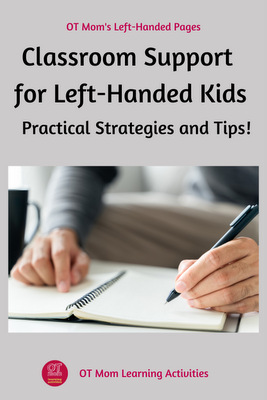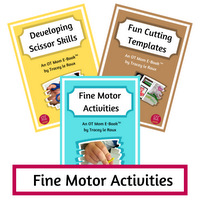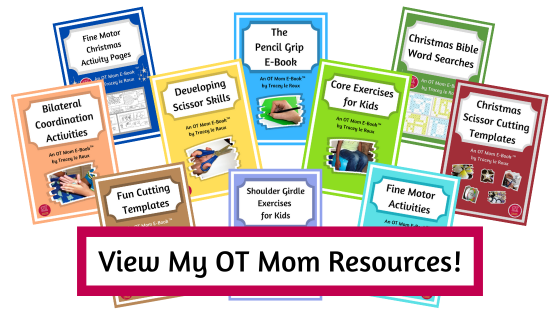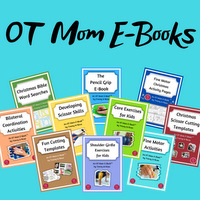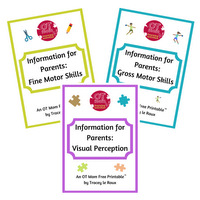- Home Page
- Skills For A Left-Handed Child
- Classroom Support for Left-Handed Kids
Classroom Accommodations For Left-Handed Kids
Right-handed parents of left-handed kids - this is for you!
Have you ever wondered if there are any strategies or tips that would help your kids at school? Left-handed kids often face unique challenges in the classroom that are not immediately obvious to non-lefties!
Many everyday items, from sharpeners and scissors to computer mice, are designed for right-handed people. In addition, the way a desk or learning station is set up can sometimes make it awkward for a left-handed child to work efficiently.
This can lead to unnecessary frustration and expended effort that takes the focus away from the joy of learning.
The good news is that a few simple adjustments can make a big difference!
On this page, you will find easy-to-implement strategies and tips to to help support your lefty today!

I sometimes link to products (#Ad) that are similar to those I use and love. If you do purchase something through my links, I will receive a small commission that helps support my site - thank you!
Key Takeaways For Busy Parents:
- Seating Matters: to avoid "bumping elbows" with a right-handed neighbor, ask the teacher to position your child on the left-hand side of a shared desk space, or next to another lefty.
- Get Lefty Tools: eliminate unnecessary frustration by investing in a few key supplies that can help make your child's day run more smoothly.
- Tips For Tests: if your worksheets have questions on the left and answers on the right (eg to draw a line to the correct answer), the child's hand will cover the question. Ask the teacher for a second copy that your child can place on the right for easy viewing, saving precious testing minutes.
- Mirror The Teacher: When teaching a hands-on skill like knitting or tying knots, a right-handed teacher should sit OPPOSITE the left-handed child, not next to them. This enables the child to mirror the movements and learn them correctly.
- Classroom seating for left-handed students
- Which left-handed school supplies are helpful?
- How do I adapt hands-on subjects for a left-handed student?
- Consideration for tests and worksheets
- Helpful resources to support left-handed kids
Classroom Seating For Left-Handed Students
What Is The Best Seating Arrangement for Lefties?
When a left-handed child is seated on the right hand side of a desk, next to a right-handed child, the elbows of their writing hands may bump.
Left-handed children should be seated on the left hand side of a desk, or with other left-handed students, to avoid bumping elbows! (Image created by AI)
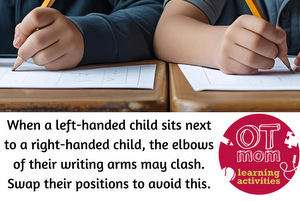
What Is The Best Layout For Left-Handed Students?
Most workstations, lab tables and computer stations are set up for right-handers - encourage your child to speak up and request permission to change the layout to make it less awkward, arranging tools, ingredients etc on the left, instead of on the right.
- When working on a table, ensure there is enough writing/working surface on the left-hand side of the equipment or computer.
- If kids are working on a project in pairs , remind your lefty to work on the left hand side of the table/equipment/project to avoid accidental knocks and bumps.

- If your child needs to write on a board,
position them to the right of the board, giving enough space for the left arm to
write without smudging the work.
So - left hand side of the table, but right hand side of a board!

What About Specialized Desks?
- Did you know that there are left-handed versions of desks? These have more writing surface and arm support on the left side.
- If your child's classroom uses chairs with writing tablets attached, you can request that there be a left version available for your child.
Which Left-Handed School Supplies Are Helpful?
- You can now get left-handed sharpeners#Ad and left-handed rulers#Ad (the numbers run from right to left, making it easier to measure), which reduces the awkward positioning and movement that lefties experience.
- Notebooks for left handed people#Ad open in such a way that the spirals and spines are not in the way of writing.
- I am a big advocate of true left-handed scissors, so read my post to find out why left-handed scissors are actually a thing!
These may seem like unnecessary purchases, but it can be very encouraging to a lefty to receive something that makes their life a little easier in a right handed world!
They make great gifts, so look out for them in stationery shops or online when shopping for school supplies!
How Do I Adapt Hands-On Subjects For A Left-Handed Student?
Many tools and instructions for hands-on subjects are designed for the right handed majority. This often results in lefties experiencing unnecessary frustration, clumsiness and embarrassment.
Here, I highlight some strategies and left-handed supplies which are designed to give lefties a more satisfying experience in learning hands-on subjects.
- Cooking Classes
Can-openers, many vegetable peelers, and the serrated edge of bread knives, are designed for right-handers. I am sure you have seen the awkward positioning that a left-handed person uses in order to use a can-opener. Sure, it works in the end, but the extra effort and awkwardness is so unnecessary!
If your child is taking cooking classes or aspires to take them one day, take a look at your utensils: Here are some things to look for:
- Does your saucepan have a pouring lip on both sides, or is it only comfortable for pouring from the right hand?
- Does your vegetable peeler have two sides? Is it comfortable to use with either hand?
- Can your can opener be used without twisting the body awkwardly
Consider investing in left-handed versions of these implements - they make great gifts for left-handed people!
Amazon stock left-handed can openers#Ad and left-handed kitchen shears#Ad, which can make a difference if your child wants to pursue cooking.
- Woodwork, Metalwork, Shop Classes
Metalwork, carpentry, masonry, welding and many other shop classes, make use of power tools and dangerous equipment. It is really important to take a close look at the safety implications of a left-handed teen making use of these unfamiliar tools and equipment.
s and dangerous equipment. It is really important to take a close look at the safety implications of a left-handed teen making use of these unfamiliar tools and equipment.
- Many tools have operating buttons and safety overrides positioned for ease of access by right-handers. Make sure that your lefty can easily operate these without compromising on safety.
- Check that your left-hander is not contorting the body to use a power tool, as this results in less control over the tool, and can be dangerous. Rather set up the work area for easier access.
- Did you realize that even a measuring tape is geared to right-handed people - when a left-handed person uses it naturally, the numbers are upside down to view! This left-handed measuring tape#Ad could be a great gift for your lefty!
- Handcrafts
When teaching sewing, knitting, crochet and other tasks, we usually come alongside learners in order to demonstrate the techniques. This works fine when you are teaching someone who has the same handedness as you do!
- However, right-handed teachers should sit opposite a left-handed student so they can mirror the technique. Teach your child to check the handedness of the person teaching them and to ask for a mirror-position to help master the technique more easily.
- Science Lab
Be aware that controls for the microscope and other lab equipment such as burettes are often on the right hand side, making it awkward for a left-handed person to control.
- Take this positioning into consideration, especially if there is a timed element involved, as it may take a bit longer for a lefty to use the equipment effectively. Ask the teacher to provide a little more time and enough space for the left-handed student to make the measurements and observations accurately.
- Computer Work
A standard computer mouse is usually designed and set up for right-handed people. Sure, your lefty *could* use the mouse with their right hand, but it's unfair to ask them to use their non-dominant hand to master something when there are some easy fixes that allow them to use their left hand and be able to concentrate on the actual task at hand.
- If you have a standard-shaped mouse, use the operating system on your computer to reconfigure the button function for left-handers.
- If your child experiences wrist and hand discomfort as many kids do, you can get an ergonomically designed left-hand computer mouse#Ad.
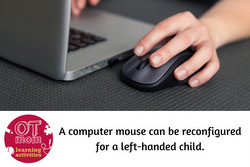
- If your teen is doing number-heavy work on their computers, please consider getting them a keyboard with the number pad on the left - it should help them work more accurately and efficiently. You can view left-hand versions#Ad here.
Considerations For Tests and Worksheets
Although many lefties won't need this additional support, if your child has a learning difficulty that slows down work, then these small adjustments to tests and worksheets can make a difference.
- Do your question papers have the questions in the left column with the answers to be filled in on the right? If so, lefties will constantly be lifting up the hand to see the next question before filling in the answer.
- Consider placing an additional question sheet on the right hand side so your lefty can see the questions on the additional sheet while filling in answers with minimum movement on the original sheet.
In Conclusion
Being left-handed no
longer carries the stigma that it did in days gone by. However, living as a
lefty in a right-handed world does have some challenges.
I trust this article will help you support the left-handed kids in your classroom, so they can focus on enjoying the learning process!
Please do consult your health professional if you are in any way concerned about your child’s development as a left-hander!
- Home Page
- Skills For A Left-Handed Child
- Classroom Support for Left-Handed Kids
Share this page to help others!
Helpful Resources for Left-Handed Kids
- OT Mom's Fine Motor Resources - a plethora of hand exercises, finger skills and much more! Suitable for left- and right-handers.
- OT Mom's Scissor Cutting Guide - everything you need to help your child master scissor skills as a right-hander or as a left-hander.
- Your Left-Handed Child by Lauren Milsom
- Do you have a younger left-handed child? Help them develop the foundational skills they need!
Didn't find what you were looking for? Try a search of my site!

